An abdominal massage focuses on the muscles that make up the abdomen region. Muscles that make up the abdomen include the transversus abdominus, the rectus abdominus and the external, internal oblique muscles. A range of techniques are used within an abdominal massage to help treat muscle tightness and tension. An abdominal massage helps to increase flexibility and decrease pain. Massage therapists at Physio.co.uk use an abdominal massage to help relieve muscle tension, tightness and pain.
What techniques are used in an abdominal massage?
There are various techniques used during an abdominal massage. Techniques used include:
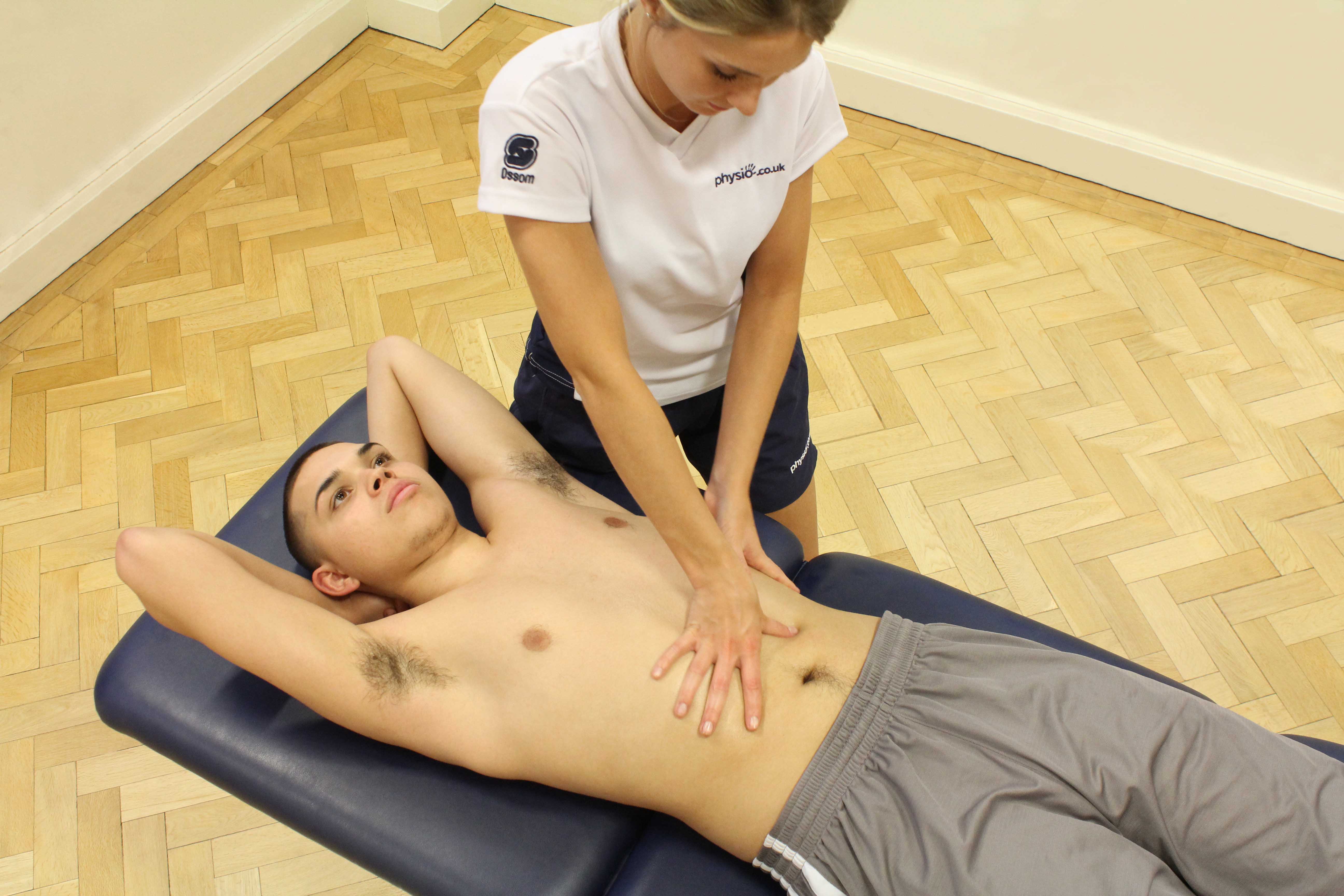 Above: Soft tissue massage of the rectus abdominis muscles
Above: Soft tissue massage of the rectus abdominis musclesA common technique used during an abdominal massage is deep strokes. Deep strokes are performed with flattened hands and fingers. Deep strokes are used to get deep into the muscle tissues so a firm pressure is applied. Deep strokes help to decrease pain by reducing muscle tightness and increasing tissue elasticity. Tight muscles are loosened to reduce restriction which may be causing pain during movement. Muscle tissues are also loosened and stretched so that elasticity is increased to help flexibility. Increasing tissue elasticity further reduces restriction. Reducing muscle tightness and increasing tissue elasticity through an abdominal massage allows a person to have an increased range of movement without pain.
Skin rolling is used during an abdominal massage. Skin rolling is where skin is picked up and rolled between the fingers and thumbs. Skin rolling is an effective way of relieving the tightness of muscle and fascia. Fascia is located beneath the skin and is a thin layer of connective tissues that can create restriction when tight. Skin rolling helps to increase the temperature of muscles and fascia to help them stretch and loosen to relieve tightness and restriction. By reducing tightness and restriction, skin rolling also helps to reduce muscular pain.
Wringing is a common technique used during an abdominal massage. Wringing involves picking up the muscle tissues from each side of the abdomen and pulling it in opposite directions towards the centre. Pressure is adjusted from light to firm within wringing. Wringing helps to relax and stretch the muscles within the abdomen, relieving any muscle tightness, tension and stress.
A technique used during an abdominal massage is kneading. Kneading is where soft tissues within muscles are slowly pulled and squeezed. Kneading helps to improve blood and lymph flow to loosen tissues. Blood and lymph flow are both increased as muscle temperature rises due to the pulling and squeezing actions of the soft tissues. Improving blood and lymph flow helps to increase cellular exchange in the tissues as there is a rise in the quantity of oxygen and nutrients to be provided to the muscles that can be exchanged for metabolic wastes. Increasing cellular exchange results in a decrease of muscular fatigue and aids in the maintenance of stronger and healthier muscles. Connective tissues are also loosened as muscle temperature increases. Pulling on the tissues helps them to stretch and increase in elasticity resulting in a decrease of restriction. Decreasing restriction increases range of movement and decreases pain.
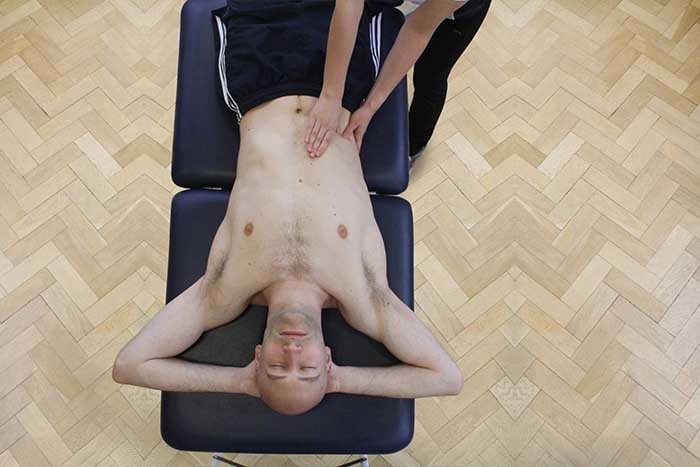
When can an abdominal massage help?
An abdominal massage can help in many different ways. Ways an abdominal massage can help include:
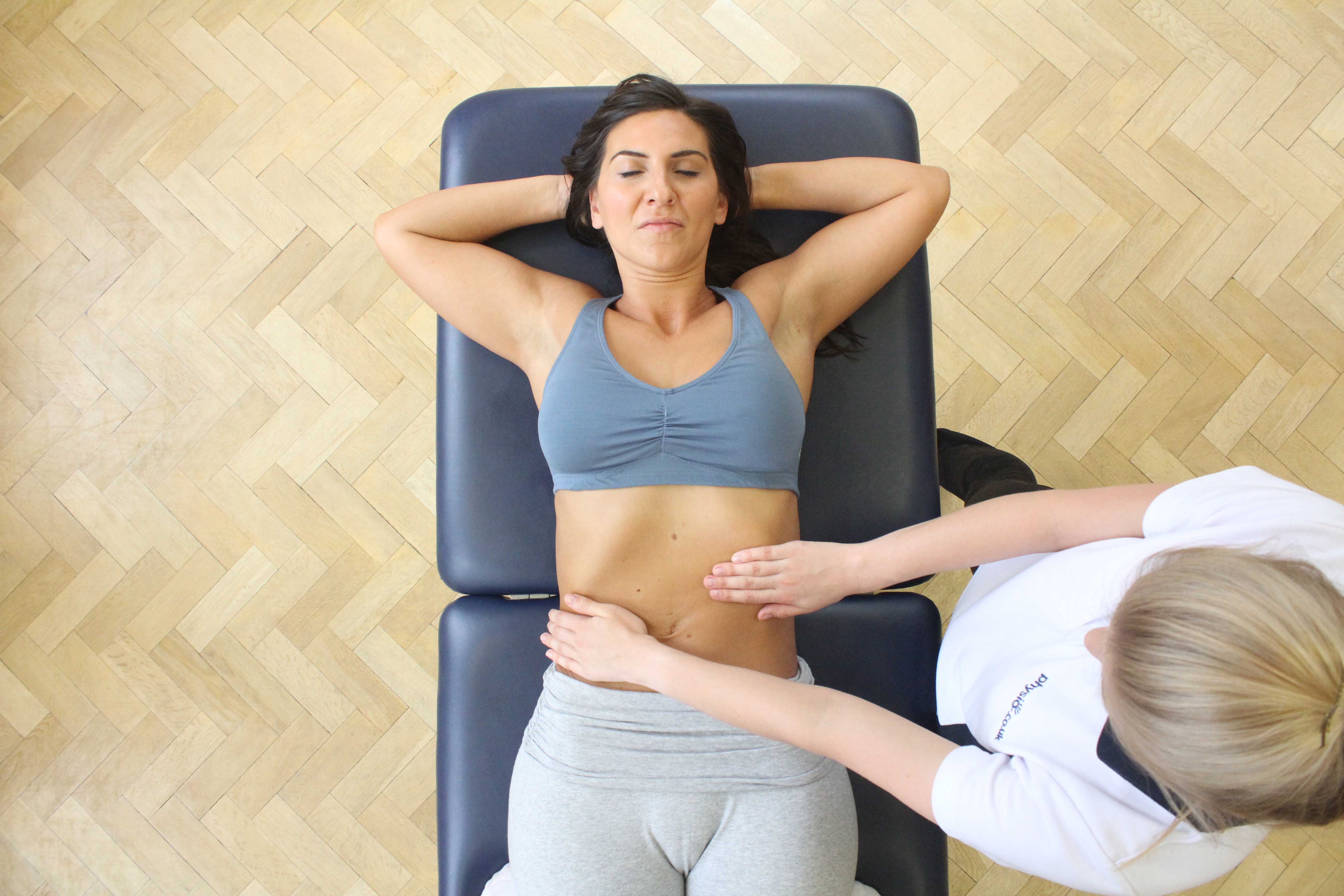 Above: Soft tissue massage of rectus abdominalis
Above: Soft tissue massage of rectus abdominalisHow does an abdominal massage help post injury?
Injury can leave negative effects on the body. After injury, muscles can become tight, restrictive and painful.
An abdominal massage aims to reduce the effects of injury by decreasing tightness and improving blood circulation.
Muscle tightness is reduced as temperature increases. Temperature is increased due to the friction created between the fingers and skin. Increasing muscle temperature loosens the muscles and allows them to stretch and move more freely without restriction. Restriction is reduced as tissue elasticity is improved. Relieving tight muscles reduces pain created by restriction.
During an abdominal massage, friction is created between the skin and fingers. When friction is created, blood flow is increased. An increase in blood circulation provides the muscles with more oxygen, nutrients and white blood cells, essential for repairing damage within the body. An increase in oxygen and nutrients also reduces the amount of fatigue within the muscles. Reducing fatigue due to an increase in blood circulation can help reduce pain that has occurred as a result of injury.
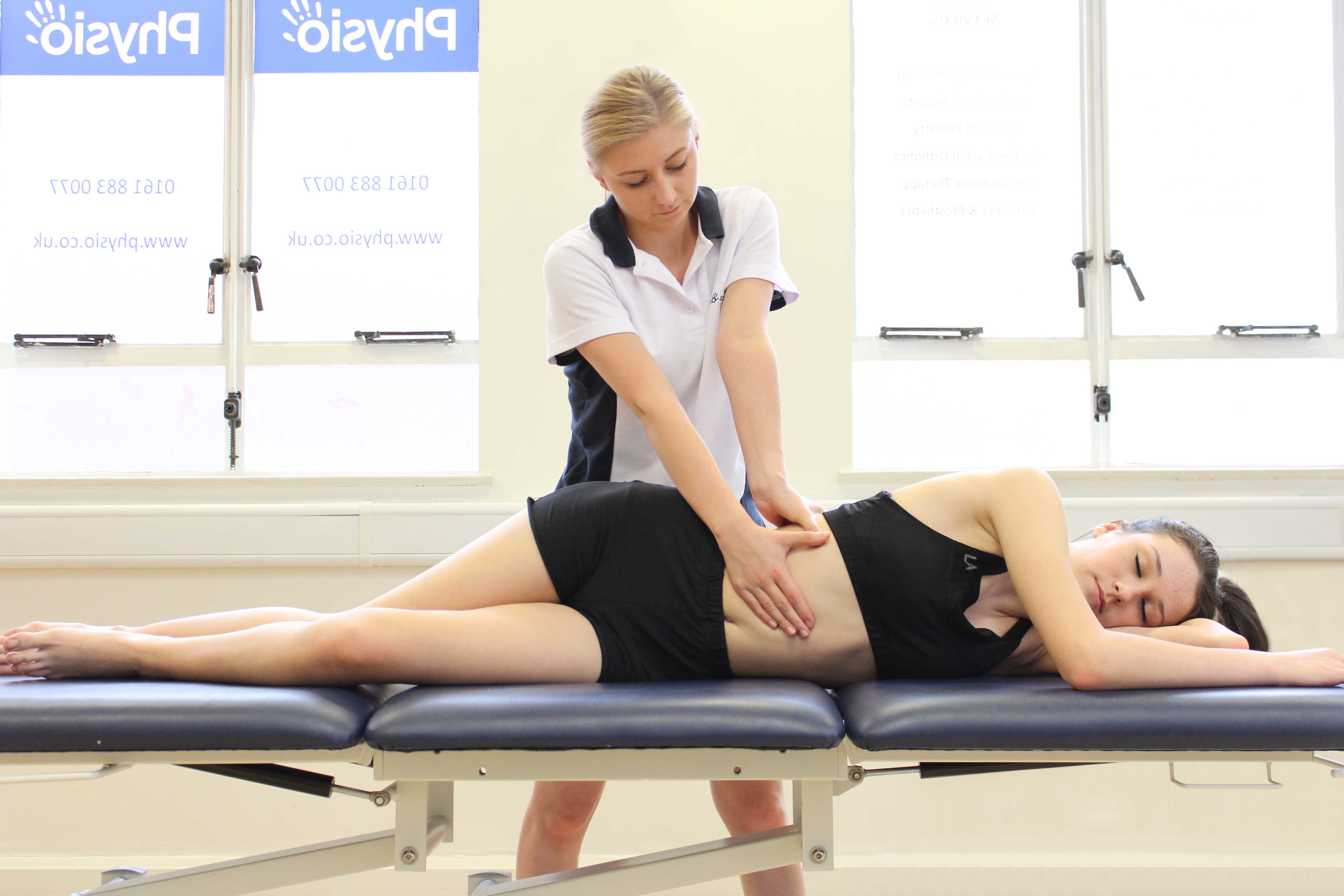 Above: Soft tissue massage of rectus abdominalis
Above: Soft tissue massage of rectus abdominalisHow does an abdominal massage help pre event?
An abdominal massage can help before intense exercise or competition. An abdominal massage helps prepare a person for activity both mentally and physically.
An abdominal massage aims to prepare a person for activity psychologically and by reducing muscle tightness.
An abdominal massage also helps to get a person psychologically prepared. There are two types of ways a person can be psychologically prepared and this can be dependent on the type of sport or activity they are going to be carrying out. One way in which a person can be psychologically prepared is by an increase in heart rate and adrenaline within the body. This way is more common for a person preparing for an activity that involves more short bursts of movements, and a lot more energy. An increase in heart rate provides the muscles with more oxygen and nutrients so that they are less likely to fatigue. An increase in adrenaline provides the body with more energy for the activity they are about to take part in.
Another way an abdominal massage can help a person get prepared for activity is by increasing relaxation hormones within the body. This way is more common for activities that require a lot more focus. An increase in the hormones serotonin and dopamine occurs, helping the body to mentally relax and concentrate, ready for the activity that is about to take place.
Before exercise or competition, muscles are more likely to be tight. Tight muscles can restrict range of movement and flexibility. An abdominal massage helps to relax and loosen muscle tightness so that restriction is decreased and range of movement and flexibility is increased. An increase in range of movement and flexibility helps to reduce the chances of injury. When range of movement is restricted, injuries such as pulls, tears and stains are more likely to occur during short bursts of movement. An increased range of movement allows the muscle to stretch further and more quickly during activity so that damage does not occur.
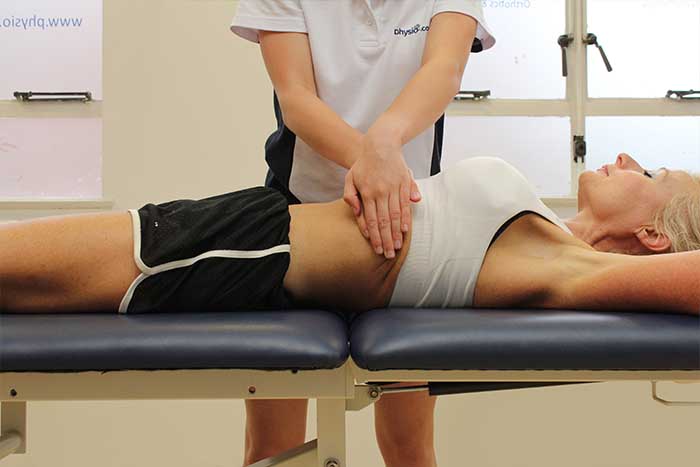
How does an abdominal massage help relaxation?
Relaxation is encouraged during an abdominal massage. An abdominal massage relaxes the body both physically and mentally.
An abdominal massage aims to relax the body physically by relieving muscle tightness that may be causing pain and psychologically by increasing relaxation hormones.
During an abdominal massage blood flow increases around the muscles, rising muscle temperature. When muscle temperature is increased, tissues within the muscles also have an increase in temperature. As muscle tissues increase in temperature, their elasticity also increases. Increasing elasticity gives muscles a wider range of movement and allows them to move freely without restriction. Decreasing restriction caused by the inelasticity of muscle tissues, relieves muscle tightness and helps a person to physically relax.
An abdominal massage helps the body to psychologically relax by increasing the level of the relaxation hormones called dopamine and serotonin. Dopamine and serotonin are secreted from the brain and can give a person a sense of well-being as well as increasing their relaxation. The level of the stress hormone called cortisol is also decreased around the body. As well as increasing stress levels, cortisol can give a person a "bad mood" effect and can also increase levels of depression. An increase of serotonin and dopamine and a decrease in cortisol allows the body to mentally relax.
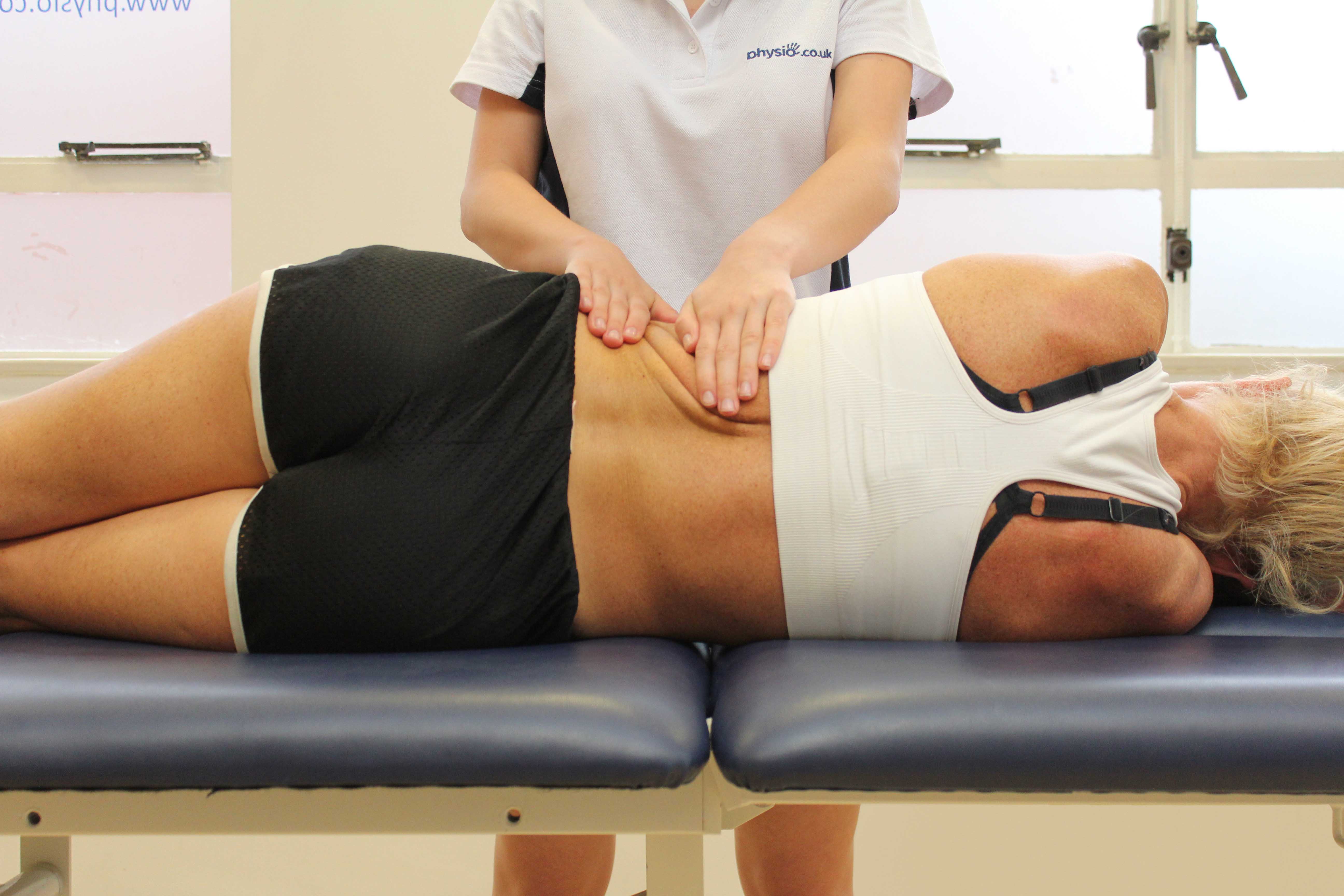 Above: Soft tissue massage of oblique abdominal muscles
Above: Soft tissue massage of oblique abdominal musclesHow does an abdominal massage help muscle tightness?
An abdominal massage can help reduce muscle tightness. Muscle tightness can be a result of injury, overuse and poor posture. Muscle tightness can worsen and cause pain if left untreated.
An abdominal massage aims to relieve muscle tightness by improving tissue elasticity.
Temperature of muscles is increased during an abdominal massage due to the increase of blood flow. An increase in blood flow occurs when friction between the fingers and skin is created. Tissue elasticity is also increased as muscle temperature rises. An increase in tissue elasticity, increases flexibility and range of movement and reduces restriction. Loosening muscles and increasing tissue elasticity therefore decreases muscle tightness.
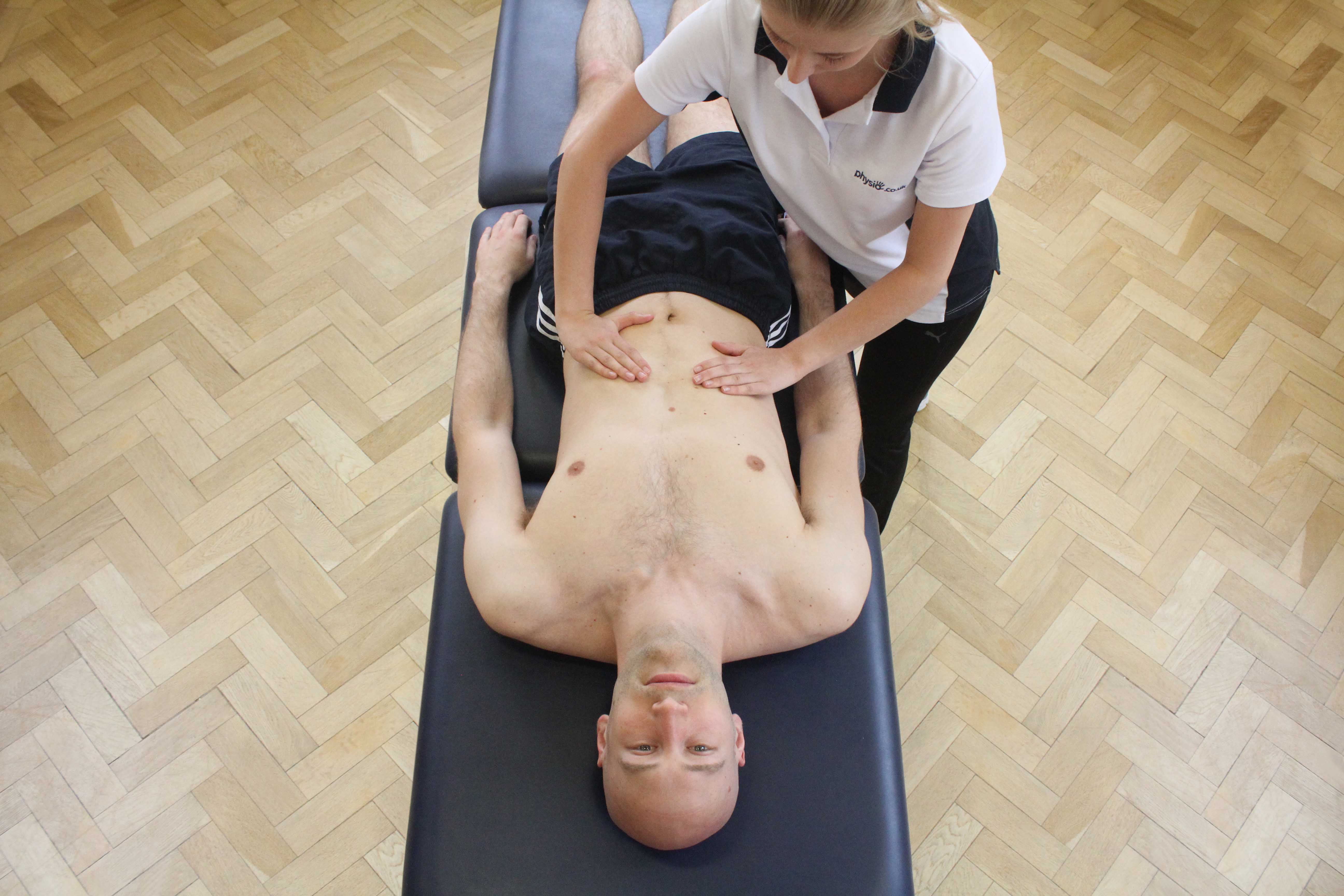 Above: Soft tissue massage of rectus abdominis muscle
Above: Soft tissue massage of rectus abdominis muscleWhat are the benefits of an abdominal massage?
There are a range of benefits gained through an abdominal massage. Benefits of an abdominal massage include:
How does an abdominal massage increase flexibility?
Increased flexibility is a benefit achieved through an abdominal massage. When muscle become tight and tissue becomes restrictive due to a lack of elasticity, flexibility is reduced.
An abdominal massage aims to increases flexibility by relieving muscle tightness and improving tissue elasticity.
Muscle tightness is reduced as temperature increases due to the friction created between the hands and skin. As temperature increases, the elasticity of muscles is increased enabling them to relax and loosen. Decreasing restriction caused by inelastic muscles allows them to stretch and move more freely without any pain, reducing muscle tightness.
Increasing the temperature of muscle tissues reduces restriction as tissue elasticity is improved. A reduction of muscle tightness and improvement of tissue elasticity both allow the muscles to stretch and move without pain, therefore increasing flexibility.
How does an abdominal massage decrease pain?
An abdominal massage can help decrease pain. Pain can be a result of many things, the most common being muscle tightness, injury and overuse.
Pain is created by receptors in the body sending a signal to the brain when damage has occurred. When the signal has been received, the brain then sends a message to the nerves to create a feeling of pain.
An abdominal massage aims to reduce pain by interfering with the signal sent from receptors to the brain so that nerves do not receive the message to create pain.
Friction created between the skin and fingers sends a new signal to the brain. A new signal sent to the brain means that the message sent to the nerves to create pain is replaced with a message to relax. Replacing the message sent from the brain to the nerves therefore reduces pain.
How does an abdominal massage improve circulation?
An abdominal massage helps improve circulation. Poor blood circulation can result in the undernutrition of the muscles and can also make the muscles fatigue more easily.
An abdominal massage helps to improve the blood circulation by increasing vasodilation and capillarisation.
Vasodilation and capillarisation is increased as muscle temperature rises. Vasodilation is where muscle cells lining the blood vessels relax, allowing them to widen. Wider blood vessels results in an increase in blood flow due to a decrease of restriction caused by the muscle cells.
Capillarisation is where there is an increase in the quantity of capillaries around the muscles. An increase in capillaries provides oxygen and nutrients to the muscles more efficiently. An increase in oxygen and nutrients allows muscles to work longer and harder during activity. An increase in vasodilation and capillarisation therefore improves blood circulation.
How does an abdominal massage improve posture?
An abdominal massage can improve posture. Muscles within the abdominal area can become tight and restrictive in movement. Muscle tightness can result in a change of posture due to the constant contraction of a muscle. When posture is incorrect, muscle tightness can worsen resulting in an increase in pain.
An abdominal massage aims to improve posture by decreasing muscle tension.
Muscles relax as tension is decreased. Tension is where muscles stay in the state of contraction and are unable to relax. Tension is decreased as muscles loosen and become less restrictive. Loosened muscles also means a decrease in muscle tightness has occurred. The relief of muscle tightness and tension allows the posture to be returned to normal without any muscular pain or discomfort.
Summary
An abdominal massage is mainly focused on the muscles that make up the abdomen. A variety of techniques including deep strokes, skin rolling, wringing and kneading are used to help in many different situations. An abdominal massage can help in situations including post injury, pre event, relaxation and tight muscles. An abdominal massage can benefit a person by increasing flexibility, decreasing pain, improving circulation and improving posture. Our massage therapists at Physio.co.uk use an abdominal massage to help treat muscle tightness and tension and reduce pain.
How can I arrange an abdominal massage?
The easiest way to arrange an abdominal massage at Physio.co.uk is to email us at office@physio.co.uk or call us on 0800 033 7800.
Alternatively if you have any questions please feel free to contact us.
We offer a 7 day service and provide home and clinic appointments.

 0330 088 7800
0330 088 7800






































